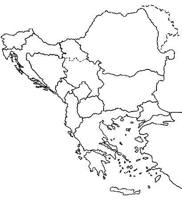
|
The Society of Folk Dance Historians (SFDH)
Balkan Words from Turkish
[
Home |
About |
Encyclopedia | CLICK AN IMAGE TO ENLARGE |

|
- The Rom language borrows readily from other tongues, but the reverse is rarely true. I would be very interested to hear of any words in common parlance in South Slavic which are Rom in origin. There must surely be some, but I cannot name one off the top of my head. This may be because I have (provisionally) misidentified as Turkish< or Greek exotic lexical items from Rom, or because I know only "standard" words, or whatever. Language gurus, help ye my unbelief! Give us examples!
- When seeking the source of an exotic lexical item in the Balkans, the a priori suspect is always Turkish (possibly as intermediary for Arabic or Persian). If the initial phoneme is "č" this intensifies to "guilty until proven innocent" (examples: "čoček", "čarši(ja)"=market, "čaj"=tea, "čorap/čarap"=stocking, "čizme/čizma"=boot, "čelik"=steel, "čardak"=porch, "čad'r"=umbrella (Bulgarian), "čoban"=shepherd, "čaush"=sergeant, wedding-marshal, "čekić"=hammer, "česma/česhma"=fountain, "čorba"=stew,...).
In the case of "čaiz," the perpetrator almost escaped our dragnet by means of a clever disguise. I had to back-distort "čaiz" to Turkish "cehiz" to get an indicting cross-reference to:
"cihaz" = "Apparatus, outfit, equipment, trousseau, funeral equipment." ["A Turkish-English Dictionary (2nd Ed.), by H.C.Hony (Oxford, 1976)].
Our Kosova-Albanian friends call the bride's trousseau "paja," and its display, both in her family's home and publicly at the time of her transfer to the groom's family home, provides major episodes of pageantry at village weddings. Sometimes the trousseau items are mounted on a huge length of cloth for the home display, creating a gigantic piece of folk sculpture draping the walls as dramatic backdrop to the intense socializing in the foreground. Traditionally, a large floor carpet woven by the bride was a central trousseau item. We understand that since the dyer's trade is no longer practiced in Prizren the making of such carpets has generally ceased, and manufactured carpets have replaced them. As part of the festive procession, accompanied by zurnas and tupan, when the bride is removed to her new home, one often sees several young men trotting along with a rolled carpet on their shoulders!
It is my conjecture that the importance of the paja as a demonstration of personal domestic competence, if not virtuosity, is a major factor in the exceptionally strong persistence of traditional textile skills among more conservative Kosovar Albanians. While purchased items are now commonly part of the paja, it is expected that many items, especially those given as gifts during the extended formalities of the wedding process, will be made by the bride.
We observed through periodic visits over many years as our personal "longitudinal study" subject, Drita Susuri of village Žur, Prizren district, learned weaving, knitting, tatting (?), embroidery of several styles, possibly spinning (the equipment was demonstrated to us by an older woman), and heaven knows what else, while creating her paja. Her loom, weighted down with concrete blocks, dominated the sunny enclosed porch overlooking the courtyard for goodness knows how long. We are delighted to report that this paid off handsomely with a happy marriage into the charming family of the village hodja (also known as Nasreddin, is a story character thought to have originated in Turkey, although his stories can be found as far afield as China), which has now produced several lively children.
Incidentally, among people you already know fairly well, the topic of the trousseau is a great way to segue into discussions of textile arts and the old ways of doing such things. And it can be a refreshing conversation-balancer, since the trousseau is in female domain, while the milieu of conversation with Honored Guests (that's you, like it or not!) is in the male domain, so that visits tend to have disproportionate male input, by our standards. Another excellent conversation-starter for those seeking anecdotal riches, and a ploy often appropriate even with folks you know only superficially, is to ask about family history. "Where does your family come from?" and a followup query or two may be enough to start a cascade of local-history stories which can give you real insight into their personal and community dynamics. It also offers opportunities for you to share analogies in your own family history and personal experience, which makes you less foreign to your new acquaintances.
Respectfully,
–Michael Kuharski
DOCUMENTS
- Balkans, a region.
- Michael Kuharski, an article.
- Turkey, a country.
This page © 2018 by Ron Houston.
Please do not copy any part of this page without including this copyright notice.
Please do not copy small portions out of context.
Please do not copy large portions without permission from Ron Houston.
